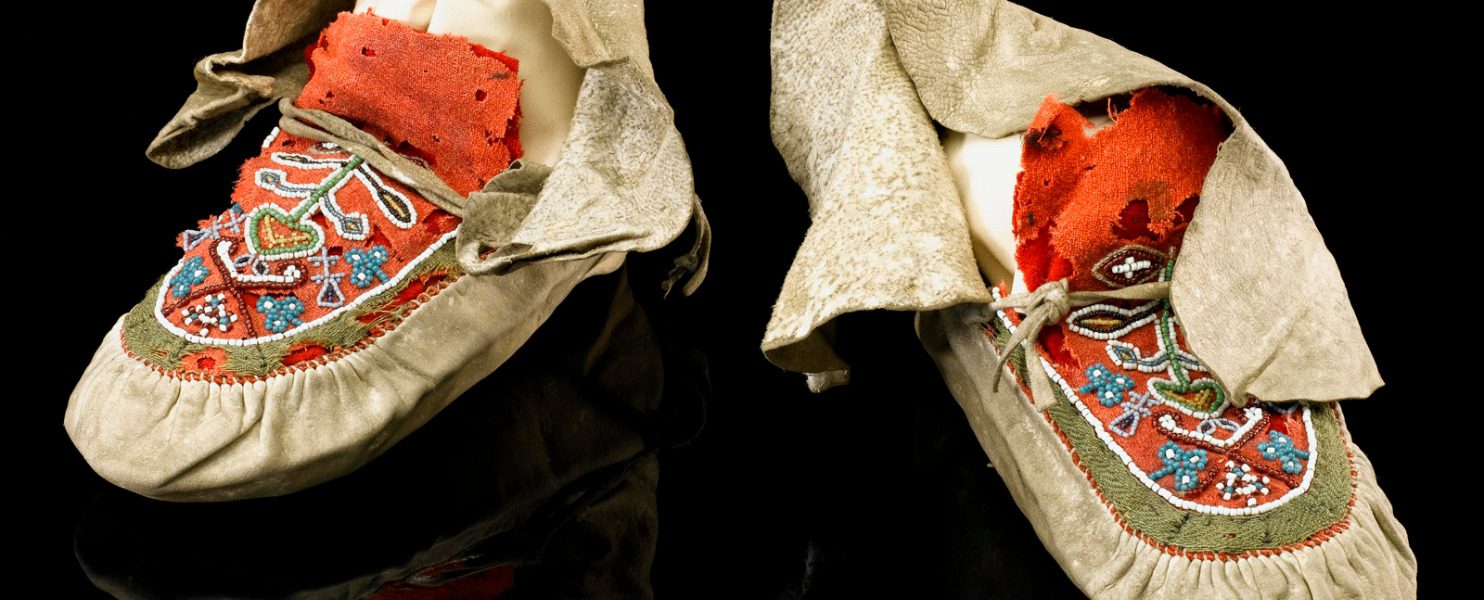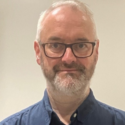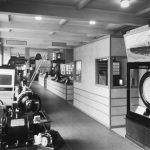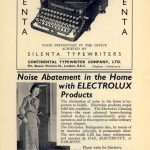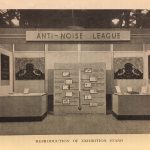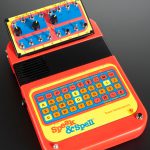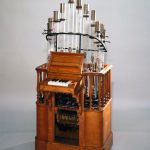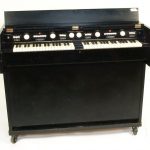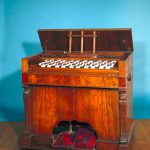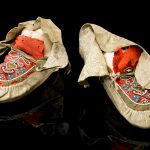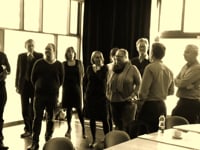‘Organising Sound’: how a research network might help structure an exhibition
Article DOI: https://dx.doi.org/10.15180/170814
Keywords
exhibition, music, noise, participation, research, science, silence, Technology
Introduction
Music, which should pulsate with life, needs new means of expression, and science alone can infuse it with youthful vigour
Edgard Varèse, 1966
The composer Edgard Varèse famously used the phrase ‘organised sound’ to connote a broad definition of what music was, and might be, within a scientific and technological world.[1] But, to pun on that definition, if a museum planned an exhibition on the interactions of science, technology and music, how would that subject best be organised? The Science Museum’s 2015 Music, Noise and Silence workshops were designed to elicit answers to that question. The conversations were valuable on their own account, not least for building a community of interest around the Science Museum Group’s sonic ambitions. But here we would like to draw together the threads of the rich and complex conversations we enjoyed in those workshops. We aim to show what they implied about the form an exhibition might take, and to reflect on this workshop approach to museum work. We also hope to illustrate some ways in which the insights of this extended collective informed our thinking about the possibilities for an exhibition, drawing on our collective perspectives in music, museology, musicology and history. To anticipate the account and argument that follows, it seems obvious to the authors of this piece that an exhibition that prioritises the sense of hearing over vision should also emphasise human practices of listening.
For a science and technology museum, few exhibition topics have more potential appeal than music. Music is a major enthusiasm for a significant proportion of museum visitors, and so there is an immediately attractive proposition to make. Music is also overwhelmingly artefactual: with the exception of unaccompanied and unmediated vocal performance, all music uses instruments and devices, to the extent that it perfectly encapsulates the relationships of technology in culture. This is a reciprocal relationship in which musical developments have affected the instruments and equipment used to realise it, whilst recording and reproduction devices have for nearly 140 years influenced the form of music. At the same time, theorising about and studying sound has been intimately bound-up with ideas about music, to the extent that key figures such as Herman Helmholtz – one of the founders of the science of acoustics – used music and their own musicianship as tools of scientific investigation. As the social constructivists would say, music, technology and science co-construct each other.
All these changes in musical instruments, experience and understanding have occurred in the era of industrial modernity. That is not to argue that music did not change before the eighteenth century, but to note that the changes have accelerated dramatically over the last two hundred and fifty years. If this has occurred against the background of industrial modernity, it seems reasonable to assume that there are causal connections between the two.
Such thoughts provoked the Science Museum’s application for funding for a workshop series in 2015. The idea was to experiment with using a research approach to thinking through the potential ingredients and structure of a possible exhibition. At the Science Museum, new exhibitions begin with curators or content developers working-up ideas that are provoked by areas of collection strength, that arise in conversations at any level in the organisation, or that are suggested by outside interests. In the early stages staff tend to work alone, or in very small groups, researching objects and subjects to the stage where a proposal is considered by senior staff. Our experiment in this project was to open-up this early stage to the insights of a wide range of informed and interested participants. We may see this as a development of participatory practice, employing the enabling capacity of academic research funding to expose our thinking to a wide range of informed participants. This liberating approach enables informed risk-taking and opens up our ideas in ways that the museum might not otherwise choose.
The possibility of an exhibition on science and music was raised in 2012, with a proposal to marry objects from the collections of both the Science Museum and the nearby Museum of the Royal College of Music (RCM).[2] Initial investigations of the collections had revealed great riches of potential exhibition display items.[3] The RCM’s is a conservatoire’s collection, rich in historical musical instruments, including variant forms. The Science Museum Group’s holdings are strong in physical acoustics and sound recording and reproduction, with a small but significant collection of musical instruments that embody the application of particular technologies, especially electronics. Drawing on these complementary collections, there are many exhibitions that we could, potentially, mount – on the techniques of manufacture of musical instruments; on the science of sound; or the psychology of musical perception, to name but three. We were left with the question of how to select a theme that would have the interest, appeal and novelty to best fulfil the potential of the broad subject matter. The fact that 2015 was the eightieth anniversary of an exhibition at the Science Museum on noise abatement gave us our hook, linking sound to industrial modernity (Mansell, 2017a). In the interwar period, noise was considered by some to be a key index of the stresses of modern life, and those who campaigned against it contrasted it with ‘peace’ or ‘silence’, as we explored in the second workshop (Mansell, 2017b). Music, too, exists in tension with silence, considered as the base referent of dynamic range; we should recall that the seconds in John Cage’s piece 4’33” amount to 273, which is also the number of degrees Celsius below zero that counts as the absolute zero of temperature, 0° Kelvin. Cage’s allusion afforded a dimension to our discussions, as implicitly as the 250 years of industrial modernity provided a temporal axis. At the other end of the dynamic range from silence, ‘noise’ has often been used as a pejorative description of avant-garde musics in particular, suggesting an axis along which many composers and musicians have been happy to travel since the consonance of the Baroque. Thus were born our three workshops: ‘Silence and Music’; ‘Noise and Silence’; and ‘Music and Noise’. Together, these paired categories enabled us to escape fixation on the nitty-gritty of the individual instruments and machines that we might display, and to think about overarching themes that might structure a compelling exhibition on science and music. Aided by AHRC funding, we were able to invite participants from the UK, Europe and North America, and we started to explore this very abstract sonic territory with some of the best, most thoughtful scholars and musicians currently working in the field.
This article commences with a brief account of the workshops (a more detailed and highly referenced version of this, including a list of the participants, can be found on the project webpage (Gann, 2010).[9] This recording was later played for workshop attendees at RCM, accompanied by the sounds of musicians practising in neighbouring rooms.
'Music, Noise and Silence': the workshops
https://dx.doi.org/10.15180/170814/001The Music, Noise and Silence workshops, organised by the Science Museum, in partnership with the Royal College of Music and University of Nottingham, comprised three, two-day events, bringing together fifty-three researchers, writers, musicians and acousticians. The titular themes of music, noise and silence provided a theoretical framework for the workshop series and the sequence of the workshops may be seen as forming a crescendo from silence to noise.
Workshop 1: ‘Silence and Music’, Dana Centre and Royal College of Music, London, 25–26 February 2015
https://dx.doi.org/10.15180/170814/002This first workshop examined how, in our post-industrial age, some new music genres have incorporated silence to such a significant degree that their works are often more silence than sound. In the introductory session, participants demonstrated the power of silence with objects and ideas that they had brought to share. Composer John Lely played a series of bursts of noise interspersed with periods of silence, proposing the silences as a pause in which the listener will anticipate or ‘forehear’ the sounds to come. Trevor Pinch brought the memory of his own sociological study of the role of silence in the act of selling, whereby the most effective salespersons used silence at crucial moments during the sales pitch. Prospective customers could not help but start talking to fill the resulting awkward silence, more often than not talking themselves into a purchase. [4]
For the first provocation, composer James Saunders provided a fittingly contentious talk entitled ‘Wandelweiser and the Contingency of Silence’, which also served as an introduction to the music to be played at the concert that closed the first day. Wandelweiser is a loose collective of composers from Europe and the USA, emerging in the 1990s to form a record label, music publisher and website (http://www.wandelweiser.de/). Their work is characterised by very long silences and very few sounds, although there is considerable variety within their scores. This consideration of silence is at the heart of Wandelweiser composers’ activities, leading to an ‘architecture of silence’, and creating ‘space […] which can only be opened with the disappearance of sound’. Shifting the balance towards silence in music thus brings with it a ‘physicality of silence’ (Frey, 1998).
The music and philosophy of the Wandelweiser group had a mixed response from the workshop participants. Although seeking intersubjectivity, Wandelweiser’s music was thought, by George Revill, to create a shared experience only at a very formalist level, and the extreme quiet and stillness of Wandelweiser concerts was compared by Hillel Schwartz to early puritan gatherings where silence and attention among the congregation would be enforced by a church Deacon using a long ‘puritan stick’.[5] It was noted that, whilst it is tempting to think that quietude in new forms of contemporary music is simply a response to ‘noisy modernity’, it is often created in polarity to current musical practices and norms. Inspiration can also be drawn from past musical influences, in Wandelweiser’s case, from the New York School of experimental music composition.[6]
The first day of the workshop concluded with an evening concert at Holy Trinity Church in South Kensington. Curated by John Lely, the concert took the form of an hour-long continuous performance of works sharing ‘an appreciation of silence, duration and listening’.[7] The opening work by G Douglas Barrett, A Few Silence (2008), explored the notion of transcribing sounds and ‘[bringing] the act of verbal notation into the realm of performance’ (Lely and Saunders, 2012). The piece consists of the instruction for performers to ‘listen to the silence’ of the performance space and respond with their own written scores.[8] The second half of the piece was the simultaneous interpretation of these individual transcriptions of sounds that occurred in the space, on a variety of instruments, objects and sound-making devices. The remaining works in the programme were by members of the Wandelweiser collective; Jürg Frey’s Wen 3 (1999/2000) interpolated solo violin with periods of silence, while Stefan Thut’s two (strings) and boxes (2012/13) made use of spatialisation as instruments were moved around the audience on resonating cardboard boxes, allowing listeners to hear from varying perspectives. Finally, Antoine Beuger’s aleatoric Kiarostami Quintets (2004) also used space by placing musicians in opposite corners of the church and augmented the chance-generated nature of the piece by giving the players free rein to microtonally alter the given pitches.
In a concert where softly played sounds and silence were performed in equal measure, the interruption of quietude and reflection by outside traffic noises was striking but wholly apposite to the forthcoming discussions, as the subject of environmental noise would be a recurring theme throughout the workshop series. Both the concert and Saunders’ preceding provocation made a clear case for music scores to be incorporated in the proposed exhibition, illustrating how composers have conceptualised silence and noise through conventional musical notation, verbal instructions and graphical representations.
The second day of the workshop began with a visit to London South Bank University’s Acoustics Research Centre. Attendees enjoyed guided tours of both anechoic and resonance chambers led by Luis Gomez-Agustina. Each small group had several minutes to adjust to the ‘silence’ of the anechoic chamber, and John Kannenberg made a field recording of four minutes and thirty three seconds of the ‘sound’ within the chamber – a reference to John Cage’s silent work 4’33’’, as well as Cage’s oft-recounted story of his own anechoic experience which led him to declare there was ‘no such thing as silence’ (Gann, 2010).[9] This recording was later played for workshop attendees at RCM, accompanied by the sounds of musicians practising in neighbouring rooms.
The second day of the workshop comprised three provocations. The first of these was an improvised performance of spoken texts and pre-recorded sounds that spoke less to the absence of sound than to various ways of silencing – of preventing someone or something from sounding. Daniela Cascella and Salomé Voegelin incorporated texts by authors including Daniil Kharms, Brandon LaBelle, Frances Dyson, and Samuel Beckett along with sounds from films such as Billy Wilder’s Sunset Boulevard and Werner Herzog’s Grizzly Man. The pair spoke about silence as an action as well as a condition, most viscerally when Voegelin increased the volume of the playback sounds to drown out the sound of Cascella’s recitation.
David Toop’s provocation began with a discussion of etiquette, drawing on ordinary representations of silence, such as ‘silence cloths’ – pads used underneath tablecloths to dampen the sound of tableware. In this way, he introduced the notion that, just as dirt is matter in the wrong place (Douglas, 1984), perhaps noise is just sound in the wrong place. Complementing the previous provocation, Toop used a mixture of readings, storytelling, and pre-recorded sound to provide examples of silences and silencing from around the world and throughout history, while insisting that silence is an impossibility since one’s consciousness is always engaged with something we ‘hear’ inside our heads, making even the alleged silence within an anechoic chamber an impossibility. To end his provocation, Toop presented a set of bells acquired on a trip to Laos; at a Hmong village he visited, women and children were forced to perform the degrading task of selling useless trinkets to tourists while the men of the village sat inside a house, using the very same bells in a ceremony. For Toop, this was an overwhelmingly sad, extremely powerful experience of silencing. During the following discussion, Toop expounded upon this experience; it made him aware that silence is a situation far too complicated to ever be resolved ethically. Salomé Voegelin responded by raising the gender issue implicit within silence: silence tends to be conceived as an idealised state only attainable by men. Similarly, it was noted that men often appoint themselves as custodians of perfection within culture, particularly in the era of mass production. Ultimately, one can argue that it is the urge to define and classify noise and silence that is gendered, rather than noise and silence themselves.
The noise of almost nothing – sounds barely perceptible by the human ear and consequently not amenable to processing without discomfort or insanity – are intimately connected with humanity’s shifting relationship with the environment, according to Hillel Schwartz who gave the final provocation of the workshop – ‘In Audibility: A provocation concerning phenomena that wobble at the elusive, possibly illusive, intersection of music, silence, and noise’. Starting from Joseph Wright of Derby’s painting ‘An Experiment on a Bird in the Air Pump’, (1768, exhibited in the National Gallery, London), Schwartz discussed the barely audible noises of terror: the ellipses, commas, and dashes of Gothic novelists; the spirit voices allegedly heard on magnetic tape in ‘Electronic Voice Phenomena’;[10] and the quest to hear the voices of single-celled organisms via sonocytology. Humans are keyed by anxiety to be more disturbed by the just noticeable rather than by the blatant, according to Schwartz, leading to a mixed sense of liveliness and loss when confronted by the noise of almost nothing.
Subsequent discussion focused on what we are intended to ‘hear’ in Wright’s painting – is it more about the conversations provoked in the observers rather than the silencing of the bird in the bell jar? And why the enduring popularity of this – to modern eyes – rather grim depiction? The best answer seemed to be that it tells a compelling story, which is what curators seek to do when choosing objects for display. This idea encapsulates what this first workshop in the series brings to the concept of a music exhibition. Schwartz was struck by the notion of ‘provocation’ and suggested that it should be incorporated into any resulting exhibition, since its etymology translates into ‘to call forth’, and surely any exhibition should ‘call forth’ a reaction from its audiences.
Workshop 2: ‘Noise and Silence’, University of Nottingham, 26–27 March 2015
https://dx.doi.org/10.15180/170814/003The second workshop, held in conjunction with the University of Nottingham’s Sensory Studies Network and hosted by Nottingham Lakeside Arts, set out to investigate the second pairing of auditory categories: noise and silence. Here, the aim was to explore the broader, ‘non-musical’, sound worlds of everyday life in which music exists. Specifically, the workshop set out to examine the sonic cultural context of industrial modernity which made noise an issue before, during and after the interwar period. To this end it centred on the Science Museum’s Noise Abatement exhibition in 1935, organised by the Anti-Noise League, a national body founded in 1934 to promote the suppression of ‘needless noise’. Concerned that new technological developments such as the motorcar and the wireless would lead to unbearable sonic chaos in the future, the League cast modern urban and industrial noise as unnatural and unhealthy, often in contrast to the natural and healthy qualities of rural sounds and the ‘right’ kinds of music. In the modern age of industry and urbanisation, listening attention has broadened to include the everyday, apparently meaningless, sounds of social hubbub. The struggle to give meaning to these ambient sounds – to understand how to hear and control them – has formed a significant part of our modern auditory culture, shaping the way we hear and think about music, silence and the sounds in between.
As a backdrop to our exploration of these issues, we installed an abridged version of the 1935 exhibition, comprising photographs and print materials from the original. Several of the talks throughout the workshop used the 1935 exhibition as their starting point. Karin Bijsterveld, for example, pointed out that the exhibition reflected the wider logic of noise abatement at the time, in its focus on engineering solutions to problems of noise. Indeed, the 1935 exhibition was more-or-less a trade show of new technologies whose aim was to measure, control, or silence everyday sound at source. Silence was a significant theme in the choice of exhibits in 1935, from the ‘Silent Railcar’ (top right of Figure 1), to the ‘Silent Lift’, and also in the adverts for various noiseless consumer technologies, featured in the exhibition catalogue, such as the ‘Silenta Typewriter’ (see Figure 2).
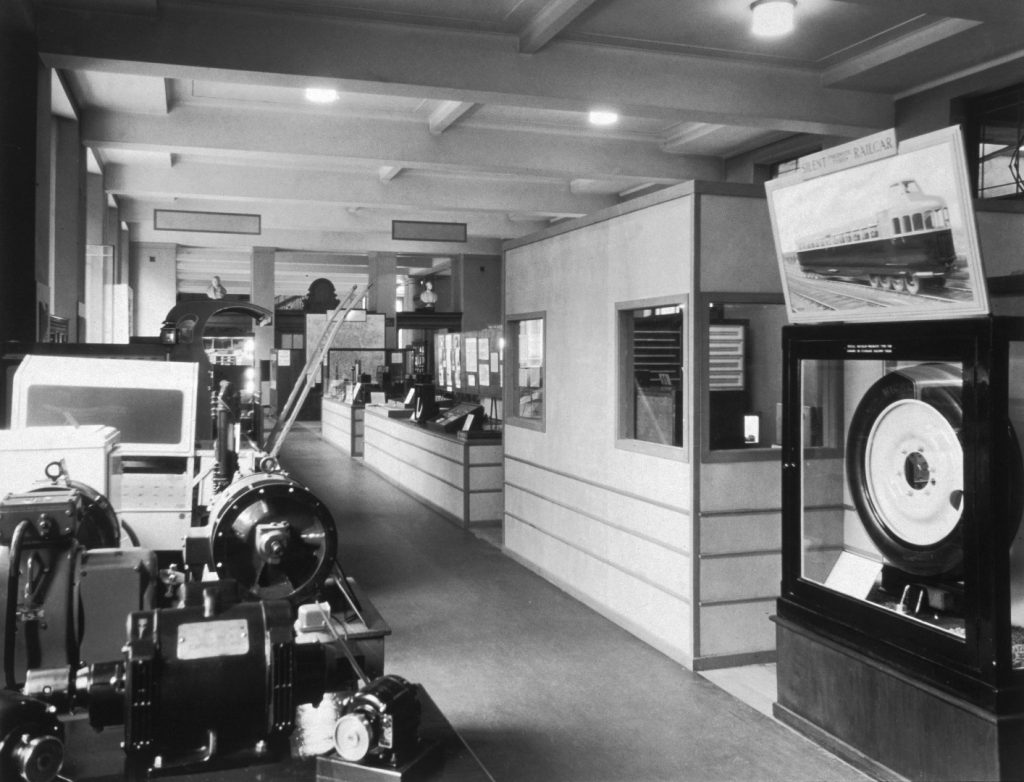
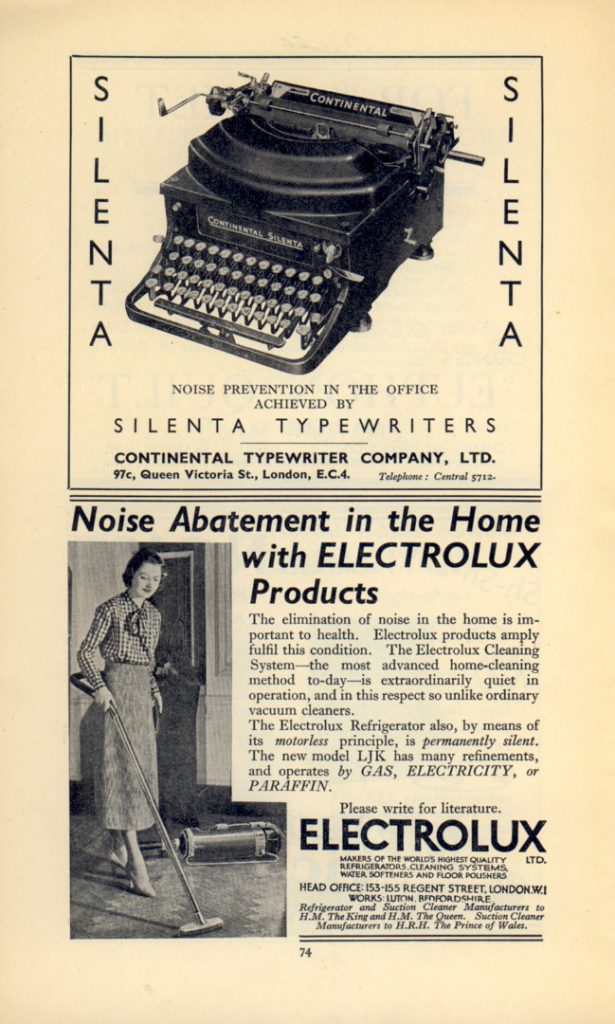
Bijsterveld noted that many of the approaches to noise begun in the 1930s have continued, including the problematic ‘individualisation’ of responsibility for noise, especially in relation to the slippery issue of domestic noise, where individuals are often left to their own devices to solve disputes with neighbours. She suggested that we might find new ways to think about neighbour noise not in the work of engineers or public health officials, but rather in that of sonic artists, who are perhaps better placed to offer us alternative ways of thinking about sonic space. For example, Sarah von Sonsbeeck’s ‘Letter to my Neighbours’ draws attention, with humour, to the sonic spaces we share by demanding rent on the space taken up in her apartment by intruding neighbour sounds. Noise is a human, social problem, Bijsterveld argued, and might be better approached not just through scientific-technical rationalisation, but also through cultural dialogue and community building; a process of coming together to establish shared consciousness of sound. That is an aim which might well be taken up in a future exhibition on sound.
If engineering and technological innovation was presented as the solution to the problem of noise in 1935, there remained nevertheless a need to give shape to the problem itself, often through medical arguments. Attempting to shift anti-noise discourse away from an association with the exceptional ‘neurasthenic’ sufferer, the Anti-Noise League claimed that noise was a genuine public health hazard, diminishing the efficiency and ‘nervous’ wellbeing of all hearers, not only those pre-disposed to aural hyper-sensitivity (Horder, 1935). However, as James Mansell argued in his talk on the second day of the workshop, the Anti-Noise League never succeeded in convincing government authorities of the health dangers of noise (Mansell, 2017b). Mansell showed that the League’s insistence that modern noise caused physical harm to the nervous system was rejected by government scientists. Instead they drew upon newer, psychological, theories which suggested that noise sensitivity results from pre-existing disorders of the mind rather than physiological disturbance to the body (Mansell, 2016). Rather than a social question, noise became a matter of the unpredictable mental variation between human beings and, indeed, as Mansell argued, a matter of the individual’s willingness to adapt to modernity and maintain mental resilience in the face of a constantly changing world (Bijsterveld, 2008). That the psychological argument ultimately won out over the physiological one in the 1930s highlights that then, and now, noise has remained politically and scientifically difficult to pin down and its fluctuating definition represents a fascinating index of our cultural relationship with sound.
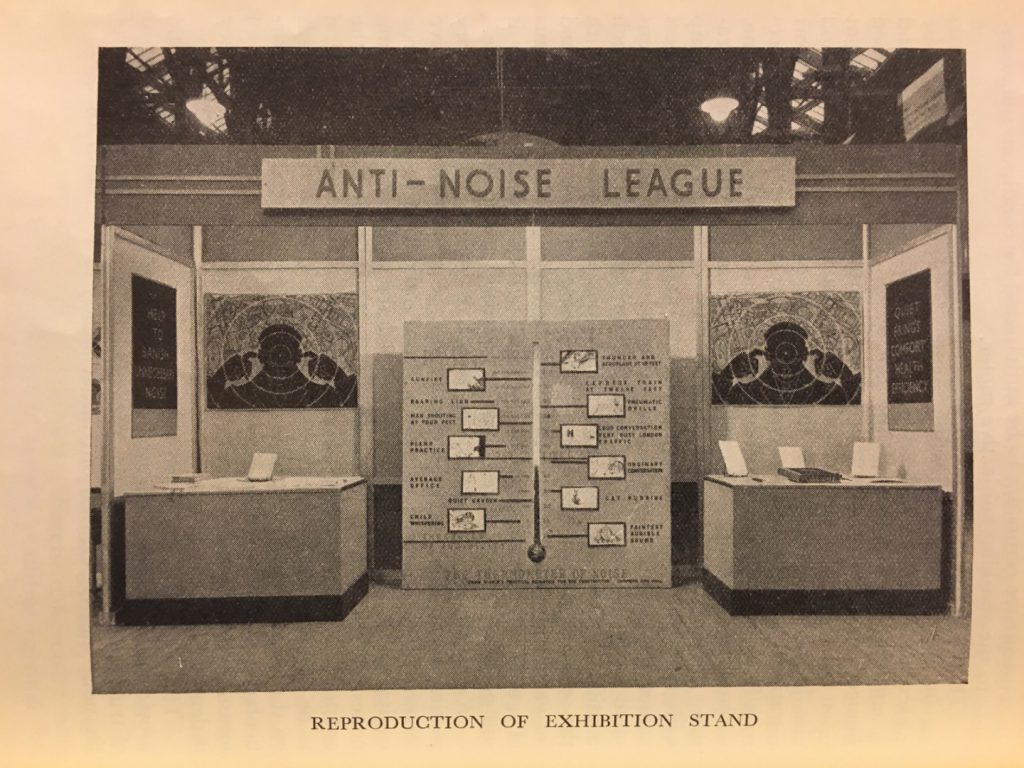
Town planning consultant Max Dixon, author of London’s ‘Sounder City’ plan – the UK’s first citywide strategy for managing environmental noise – reminded us in his talk that state-funded action on noise is still justified and financed not primarily on cultural grounds, but rather on medical ones (Dixon, 2004). Dixon pointed to the most recent studies on the health effects of noise, which attempt to make a case for a causal link between noise and raised blood pressure and cardiovascular disease. He called for ‘sustainable soundscape co-creation’ rather than noise abatement, pointing to the need for industry, government and citizens to work together to create more liveable sound environments. However, he expressed doubt about arts interventions which encourage a very close listening attention to the everyday sound world, because, in his experience, we depend upon our ability to adapt to environmental sound by learning to ignore it, or at least not listening to it in detail. As evidence for this, Dixon pointed to the Darlington Quiet Town experiment of the 1970s, during which the population of a single town were targeted with a noise awareness campaign together with significant reductions of environmental noise achieved via traffic re-routing. The result was that people became in fact more likely to complain about disturbing sounds, despite a measurable reduction in noise levels, because they had been newly sensitised to their sonic environment (Noise Advisory Council, 1981).
John Levack Drever, sonic ecologist and sound artist, made an important intervention by insisting that in noise and sonic product design, we still place too much emphasis on sounds themselves, and not on how we hear them. Indeed, Drever is sceptical about a singular category of ‘hearing’, since, as he pointed out, we all hear differently due to age-related hearing deterioration and to conditions such as hyperacusis (intensified sensitivity to certain frequencies of sound). These afflict a significant number of people, but are not usually taken account of in the acoustics of product design. His provocation suggested that we should move away from a normative ‘auraltypical’ theory of audition, to a model of aural diversity in which we take account of our multiplicity of hearing modes. He pointed out that hearing also varies culturally, offering the example of Japan, where some women are hyper-aware of sounds made in public toilets, and carry personal sound-emitting gadgets for the purposes of sonic modesty. Such devices might make interesting exhibits, as would artefacts from the history of hearing aid development, pointing as they would to the significant differences in our hearing abilities and to the need to take account of our diversity of hearing experiences.
On the second day of the workshop, anthropologist of hospital soundscapes Tom Rice returned to the question of the medical arguments made against noise (Rice, 2013). Pointing out the longue durée of the noise-as-problem discourse, from the 1930s conflict between physical and psychological medicine to the contemporary uncertain and contested science on the impact of noise on health, Rice showed the extent to which anti-noise claims depend upon medical underpinnings. Rice reminded us that Florence Nightingale was the first to promote quiet conditions in hospital wards and pioneered the use of quiet slippers for nurses. He argued that throughout the modern history of noise abatement, appeals to the need for quiet for convalescence, and more widely the argument that noise is a cause, or at least a prolonging factor, in illness, has been a major, if not the major theme in the noise abatement campaigns of industrialised nations.
Cultural historian Shelley Trower prompted us to think beyond audible noise to the category of vibration, often discussed in connection to noise, but sensed, she argued, beyond its audible registers (Trower, 2012). Turning to Victorian literature and medical writings, Trower argued that the cultural relationship with modern machines was encapsulated in discussions of vibration and vibratory affect, sometimes audible, but often with effects beyond the sonic. Railway travel is a good example, she said, of a new technology which prompted anxiety about unseen, sometimes unfelt, forces forging what were perceived to be unnatural bonds between machine and body, causing the latter to resonate in damaging ways. Noise was part of this discussion, but tied up with it was an intense general anxiety about unheard and unseen forces in the Victorian period. Trower argued that, as with noise, scientists set themselves the task of knowing and controlling these unseen forces, going to elaborate lengths to depict them in visual form. Such visualisation, including later developments in noise meter technology, could certainly provide a very interesting dimension to an exhibition on sound.
In the final talk of the workshop, media historian David Hendy drew on research for his BBC Radio 4 series Noise: A Human History (Hendy, 2012) to turn attention away from science, knowledge and policy and towards questions of social politics. Hendy argued that noise is best defined not universally as sound out of place, but instead as sound designated by a particular kind of person, in a particular kind of place, as unwanted in their specific cultural context. Hendy insisted that such designations always tell us something about power, whether of the wealthy over the less wealthy, of men over women, or of older generations over younger. He argued for an approach blending both macro and micro approaches to the analysis of noise’s entanglement with power. On a global scale we should remember that, when we settle down to quietly read a book, others have endured the sound of the logging, pulping and haulage distribution of the artefact in our hands. On the micro-scale, experiences of daily noise imposed on those who must live and work in earshot of unceasing din barely register in the consciousness of those who are lucky enough to have access to quiet, but are nevertheless part of the way in which inequality is sensed and felt. Hendy’s call to search out these experiences in court records, diaries and in other forms of less obviously sound-related source material could certainly provide a way of accounting for the socio-political dimensions of noise in an exhibition.
In addition to talks and discussion, the second workshop featured practical interventions intended to stimulate debate about how to engage museum goers in an exhibition about sound. These included presentation of a new sound art commission by Audialsense, a sound art group consisting of architects Paul Bavister and Jason Flanagan, and acoustician Ian Knowles, who specialise in installation works revealing the acoustic properties of architectural spaces. The piece, entitled Walk, exploited the acoustic peculiarities of the Trent Tunnel, a long, curving, underground walkway connecting two of the major buildings on campus. Walk consisted of a base sine wave of 70 hertz along with a combination of other pure tones based on a Japanese scale, plus the sound of ghostly footsteps accompanying the visitor as they moved through the tunnel. Only by moving through the space and traversing its unique acoustic qualities would the combination of tones merge to form a constantly shifting, echoing, whole.[11]
Walk was installed for two full days of normal university life and transformed the tunnel from a humdrum zone of transit to a remarkable place of reflection. Travellers slowed their pace as they moved through the sonic tunnel, becoming more aware of the sound of their own footsteps, stopping to look up and around, and to wonder about the sounds around them. Bijsterveld’s point about the sonic skills of artists is thus an important one: artists can enliven our sense of hearing, causing us to experience place and sound differently.
The second day of the workshop included a re-enactment of the recording of a 1929 sound effects recording,[12] led by Aleks Kolkowski and composer/conductor Jean-Philippe Calvin. Using a vintage recording lathe to cut direct to a 78rpm disc, the group’s recreation of an orchestrated crowd scene was recorded to video as well as disc.[13] The resultant hubbub, which crescendoed to an uproar, is typical of crowd recordings of the period, which were orchestrated in the studio by groups of actors or extras under strict direction (Napier, 1936, p 94).
The recording activity provoked discussion around the nature and use of recorded sound effects in theatre, film and radio, and of hyper-reality in sound production, where natural sounds have been greatly exaggerated or replaced with artificially produced sounds in order to enhance the medium they serve (for a critical account see: Whittington, 2011). Workshop participants remarked on the phenomenon of commercial sound effects libraries, with sounds recorded in previous decades being reused in cinema and radio, even to the present day, to the extent that the repeated use of some specific sounds has made them easily recognisable, even irritating, to those who listen closely.[14]
The recording activity also introduced an alternative thread to the workshop theme, namely the noise of the crowd. Rather than thinking of noise solely as it was defined in the 1935 Noise Abatement exhibition, where the noise of industrial modernity is generated by machines and by people using those machines, the human noise of the crowd is also important to the experience of modernity. It can be seen as being a key constituent of the all-consuming modern metropolis with its masses of inhabitants.
It is clear that there would be no shortage of compelling artefacts relating to noise and silence to include in an exhibition. Some of the objects from the Science Museum’s 1935 Noise Abatement Exhibition, such as noise meters, are still in the Museum’s collection; promotional materials made by the Anti-Noise League still exist, and perhaps materials relating to the Darlington Quiet Town experiment mentioned by Max Dixon could be located in an archive, too. Artworks such as those mentioned by Karin Bijsterveld would contrast interestingly with scientific objects, and Audialsense’s approach to changing our listening attention could be effectively deployed in the museum space as part of, or alongside, an exhibition. Crucially, in seeking to take account of the sonic categories of noise and silence, any exhibition would have to account for the essentially contested and political nature of the struggle to define quiet. Who decides what constitutes that ideal compromise between noise and silence? Who gains and loses access to it? How is it promoted and measured by scientists and policymakers? These questions cut to the core of what it is to live together in modern societies.
Workshop 3: ‘Music and Noise’, Science Museum, London, 23–24 April
https://dx.doi.org/10.15180/170814/004The final workshop in the series asked if, categorically, the opposite of music is said to be noise, then in what ways has the boundary between music and noise been negotiated? This workshop began at Blythe House, the Museum’s storage facility in West London, with a guided tour of the Sound Reproduction and the Acoustics collections led by John Liffen, Curator of Communications and Acoustics. Liffen also assembled a selection of the Museum’s artefacts for the afternoon’s provocation by historian of science Myles Jackson, author of Harmonious Triads: Physicists, Musicians, and Instrument Makers in Nineteenth-Century Germany (2006), who invited us to think about the history of late eighteenth- and nineteenth-century acoustics through the selection of objects laid out before him. Just as the workshop’s aim was to problematise the boundary between music and noise, Jackson’s talk problematised the boundary between scientific and musical instruments. Musical instruments provided experimental natural philosophers, physicists and physiologists with a rich choice of natural phenomena needing explanation, such as combination tones, beats, resonance, vibrations and wave patterns. Using objects from this rich collection, Jackson surveyed the work of many researchers in this liminal region, beginning with the founder of experimental acoustics, Ernst Chladni, whose ‘Chladni Figures’ – patterns formed by grains of sand on a metal plate made to resonate with a bow – are among the earliest visualisations of sound. By describing work such as Thomas Young and Hermann Helmholtz’s piano-mediated research on tuning systems and combination tones, Helmholtz and Hermann Koenig’s dispute over the nature of combination tones (Pantalony, 2009, p 133) and the early sound-based experiments[15] that informed Charles Wheatstone’s important contribution to the development of electrical telegraphy, Jackson argued for the inextricable relationship between scientific and musical experimentation. Using scientific instruments such as the tuning fork and the siren, physicists began to reconceptualise the notion of hearing and of sound. Returning to the siren, Jackson ended his provocation with a discussion of how the boundary between scientific and musical instruments became blurred during the twentieth century. For example, Edgard Varèse’s piece Ionisation (1929–31) was inspired by science in its use of sirens – not to evoke a factory, police or alarm sound but in order to create glissandi effects and liberate the sound from pitch relationships. Varèse believed that composers must work with scientists and electrical engineers to produce new sounds and he foresaw that physics and electricity would create a new musical aesthetic. In conclusion, Jackson argued, just as music and noise are historically contingent categories that would be redefined throughout the late eighteenth, nineteenth and twentieth centuries, similarly the boundary between musical and scientific instruments becomes blurred during this period.
As part of this third workshop an evening concert of new works responding to the theme of ‘Music and Noise’ was performed at the Science Museum by three of the workshop participants. Aleks Kolkowski’s Sounding a Victorian Future (2012–2015) presented his own recordings of working machines in the Science Museum collection, including the reconstructed Charles Babbage’s Difference Engine, the Toyoda loom and the giant Burnley Mill engine.[16] The recordings were transferred onto wax cylinders and reproduced mechanically on early twentieth-century Edison cylinder phonographs with giant brass concert horns,[17] effectively ‘ageing’ the sound, as if the audience were hearing recordings of machines made in the distant past. Sean Williams presented an improvised performance derived from Gottfried Michael Koenig’s Funktionen (1967−79),[18] on modular analogue synthesiser. The evening concluded with Sarah Angliss and Caroline Radcliffe’s mixed-media performance work, The Machinery, which combined recordings of machines, electronic music and video projection with live ‘machine-mimetic dance from the early nineteenth century’ (that is, Lancashire clog dancing) performed by Radcliffe.[19] Devised by women working in the Lancashire mills, the steps of this nineteenth-century ‘heel and toe’ clog dance directly mimic the repetitive sounds and movements of cotton mill machines. As well as the sounds of the mill, the piece used those of a modern call centre, juxtaposing the sounds of industrial manufacturing factory work with those of the modern-day service sector.[20]
The second day of the workshop began with a hardware hacking session led by Tom Richards; a practical activity in which the participants assembled their own, functioning, light-sensitive Theremins, guided by Richards’ easy-to-follow instructions. The session ended in a spontaneous improvisation session by an ensemble of the newly created instruments. Reaction to the activity was overwhelmingly positive, with the obvious implication that activities of this type would be a valuable addition to a sound-focused exhibition. This tactile, listenable activity contrasted with the silenced objects on show during Myles Jackson’s presentation the previous afternoon, raising the question of how this disjunction could be addressed in an exhibition context – perhaps by using recordings of the objects on display or digitally modelled versions of them. However, it was felt that the difference between hearing an actual object sounding in space and listening to a recording of it is potentially so great that live demonstrations of certain artefacts, or working replicas of them, would be more effective in an exhibition on sound.
DIY electronics and hardware hacking (the practice of physically modifying pre-existing electronic hardware) has played a significant role in electronic music production in the twentieth century through to today. In his provocation, Trevor Pinch drew from his own experiences as a musician and builder of a modular synthesiser to examine the appeal of unpredictable and malfunctioning instruments of electronic music-making that are the wilful result of a practice known as circuit-bending. Coined by composer Reed Ghazala, the term derives from the bending of wires that link components within an electronic circuit (Ghazala, 2005, p 3). Circuit-benders typically take existing, battery-operated electronic devices and toys that produce sound, and modify their circuits by adding new wire connections to change the sound produced. Mass-produced electronic toys such as the ‘Speak & Spell’ and the ‘Furby’ have become classic tools of circuit-benders, allowing for exploration and experimentation with electronic hardware at very low cost, low risk, and without requiring any previous knowledge of electronics.[21] This tactile approach to creating sounds and instruments is an important factor in the appeal of circuit-bending, as is the element of chance and unpredictability. The instability of the instrument and potential for producing unexpected results is considered important, especially when improvising. The circuit-bent device has an agency of its own, producing a glossolalia of electronic sounds almost unaided and in complete contrast to how it originally sounded as a commercially manufactured toy. The circuit-bender’s ‘tactile understanding’ of technology, which doesn’t require knowledge of electronic schematics, enables them to take control of the technology. In a museum context, this would make circuit-bending an ideal learning activity, where visitors can engage in a tactile manner with the technology and at the same time gain an understanding of how electronically produced sound works.
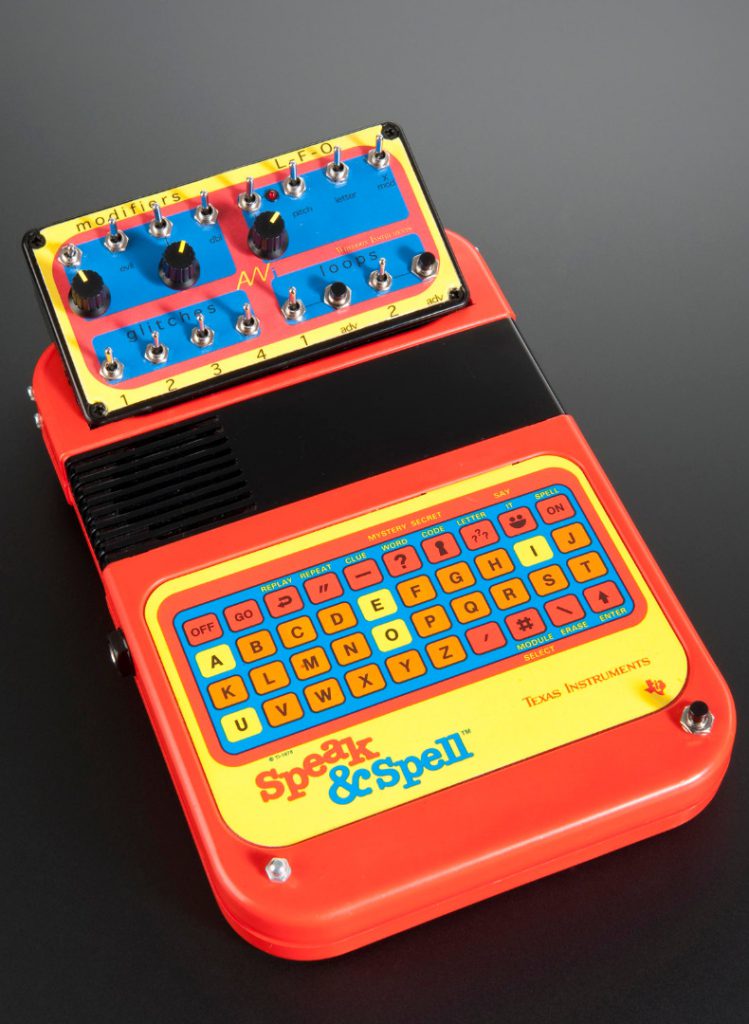
A DIY aesthetic was also very much present in industrial music’s early period. Alexei Monroe, in his provocation ‘A Violent Absence: Re-Industrialising the History of Noise in Music’, stressed that no accurate narrative of the history of noise in twentieth-century music is complete without discussing the role of noise in Industrial and Techno music. Industrial music has a troubled image and Monroe began by contrasting the critical acceptance of the Italian futurist movement (despite its affinity with Italian fascism and vehement glorification of militarism) with what he sees as the ostracising of Industrial music by academics and music journalists because of its politically contentious and ambiguous nature. Where Futurism celebrated noise as a tool for anarchy and revolution (Harrison, Charles, and Paul Wood, 2002, pp 146–149), Industrial music uses noise itself as power. It does this through visceral, amped-up loudness as well as symbolic visual representations of power, for and against ruling systems and even against audiences. Modern industrial music, Monroe argues, is a complex, contradictory mix of ambivalence, ambiguity, confrontation and social tension that was fomented during the 1970s – a period of rapid de-industrialisation, social unrest and upheaval in Europe and the USA. Cabaret Voltaire and Throbbing Gristle, two British groups from this period, were highly influential and made innovative use of noise and distortion, using self-built devices, synthesisers and electronic effects in their music. Throbbing Gristle’s record label, Industrial Records, founded in in 1976, gave name to the new genre of Industrial music, strongly associated with dystopia, alienation and political and moral ambivalence. Monroe also sees the experimental electronic music of the BBC Radiophonic Workshop as a direct influence upon the Industrial music of the 1970s and ‘80s, citing the incidental music created by Malcolm Clarke for ‘The Sea Devils’ (1972) – an episode from the BBC television series Doctor Who.[22] For much of the general public, these television soundtracks were their first exposure to abstract electronic music outside the popular music realm and they inspired and influenced a generation of musicians.
Industrial music’s tendency to dehumanise both musician and listener may be seen as a reaction to the personality-driven and virtuosic rock music of the period. This tendency was amplified, according to Monroe, as Industrial music influenced the advent of Techno in Detroit during the 1990s. Industrial music continues its relevance within the political sphere today, an example being the Industrial band Skinny Puppy’s ongoing lawsuit against the United States government, who used the band’s music as a sonic weapon of torture at the Guantanamo Bay detention camp.[23]
The discussion following Monroe’s provocation considered other music and art forms that have arisen from the industrial context but were created by workers, such as singing in the workplace and clog dancing, contrasting these with the brutalist noise aesthetic of Industrial music created by artists. It was suggested that in our post-industrial society, modern Industrial music seems oddly nostalgic. The problem of how best to represent Industrial music and its radicalism within a museum context was pondered; it would be essential to provide ample video footage and visual material even to gesture to the controversial nature of the genre. Specific objects that could be exhibited include the ‘Gristleizer’ effects machine, used by Throbbing Gristle for making pounding echo effects;[24] Synthi AKS and Korg MS20 synthesisers; the E-MU Emulator 2 sampling keyboard as well as metallic ‘junk percussion’ instruments.
Sarah Angliss, in her provocation, moved away from the music-science relationship to the ‘emotional contagion’ that binds musician and audience. Angliss expressed curiosity regarding deeply committed emotional reactions to listening, and the sacrifices listeners are prepared to make for the experience – the experience of temporary tinnitus, or ‘ringing in the ears’ after a loud concert, for example, which she likened to visiting an art exhibition because one wishes to see a lot of the colour red, whilst knowing one will be ‘red blind’ for a few days afterwards. Further exploring these emotional connections to music, Angliss wondered why so-called ‘audiophiles’ continue to strive for perfect sound fidelity, despite the scientific ‘proof’ that such perfection is impossible. Here Angliss referenced sociologist Marc Perlman’s division of audiophiles into two major groups: ‘golden ears’, who believe the exceptional precision of their own hearing abilities can distinguish qualities in recordings undetectable by either ‘normal’ listeners or by technology, and ‘meter readers’, who stand by the reports and measurements of high-quality audio technology (Perlman, 2004). Angliss responded to a question about the sense of spectacle in live noise music and how this relates to emotional contagion, by mentioning the importance of visual cues and gestures made by performers that are synchronised with the performed sound as a cause of, or ‘cue for’, emotional contagion. The relationship between the desire to listen to extreme volume (noise music fans) and extreme silence (audiophiles) was also clarified as a matter of signal-to-noise ratio rather than simply of the workshop’s governing categories of noise and silence.[25]
The ratio of signal-to-noise was purposefully low in an unusual provocation/performance by composer Luciano Chessa. Chessa combined live readings with pre-recorded speech, digital noise and a megaphone to present a metaphysical investigation of Luigi Nono’s teleological musical form within the ending of his oft-performed composition La lontananza nostalgica, utopica, futura (1988–89).[26] With much of the content of the talk obscured by either loud noise or the confusion of two voices speaking different texts simultaneously, Chessa created a tension between an explanation of purpose and that explanation’s inability to be comprehended, leading to an uncertainty in the audience about what they should be hearing from the performance.
How do we qualify noise of a different order? Sally-Jane Norman, in her workshop summation, pondered this question while discussing the European Space Agency’s 2001 artist residency programme.[27] This a group of artists turned a radio telescope into a musical instrument, with the collected data from the transmissions being held in an open-source archive for others to study and remix.[28] In thinking about crafting an exhibition for the Science Museum, Norman suggested we think about the things we are currently training ourselves to listen to. She suggested we think about the physicist and philosopher Karen Barad’s post-humanist notion of intra-actions, which reverses contemporary opinions about causality and rethinks our relationship with objects, enacting boundaries of tuning and hearing in entirely different ways (Barad, 2003). Norman also discussed François Delalande’s reflections on different modes of listening, including empathic listening, which is ‘entirely oriented towards sensations produced and not towards what causes them’ (Delalande, 1998, p 46) and figurativist listening, where sound is interpreted as narrative or as metaphors, and where the listener ‘tends to think that certain sounds evoke something that moves, ultimately living’ (Ibid, p 47). In an exhibition context, would the Science Museum prefer to craft something empathic, where visitors feel a sense of connection with the objects they are listening to, or employ exhibition strategies focused purely on narratives and taxonomies? Perhaps a Science Museum exhibition on sound should focus on counterpoint between these two approaches, Norman argued, embracing its soundscape’s own sharawadji – its unexplainable beauty through complexity (Augoyard, et al (eds), 2006).
'Music, Noise and Silence': emerging themes
https://dx.doi.org/10.15180/170814/005Context: industrial modernity
That the network series explored the path of music’s development over a quarter millennium within the context of the rise of industrial modernity is more than coincidence. Music in this era, we proposed, has been a cultural component of a world responding to industrial change and employing the resources of the sciences to do so. Our insistence that the workshops use the very broad temporal context of scientific and industrial modernity paid dividends in enabling us to take the long view inclusive of many different musical forms as well as a plurality of scientific and technological developments. But industrial modernity can be considered as having many differing relations to music: it might merely be the background context against which music has changed. It might be an umbrella term for the technologies that are put to work in creating new materials, instruments and devices to create and reproduce music. In its association with science, using the category of industrial modernity might enable new understandings of sound and music and how we perceive them. Myles Jackson’s demonstration in the third workshop exemplified the links between industrial capability and musical instrument making. Using items from the Museum’s collection he illustrated the argument of his book Harmonious Triads (Jackson, 2006) that instrument makers, musicians and physicists had all worked together in the nineteenth century. The noise of industrial modernity might also be an inspiration in noisy forms of music. Across the nineteenth century, symphony orchestras also grew substantially in size and volume, requiring new instruments to be created, especially in the bass register, to be heard against the other instruments. Furthermore, the rhythms of industrial sound might render novel kinds of rhythmic music acceptable and attractive, or provoke a reaction in the composition of particularly quiet and contemplative musical styles. The workshop series exposed the participants to many of these ideas and possibilities.
Although the workshops’ main concentration on the noise of modernity was on the interwar period, the relevance of the direct impact of older industrial noise was particularly evident in the performance of Sarah Angliss and Caroline Radcliffe’s piece, The Machinery: Clog Dancing as Early Noise Music, part of the evening concert in the third workshop. Lancashire clog dancing was far from a rural tradition; it was a response to the sounds of the cotton weaving mills. In Radcliffe and Angliss’s reading, the repetitious rhythm of weaving looms forms a proto-Industrial music soundtrack to a mechanoid dance.[29] The resonances with Alexei Monroe’s account of recent techno and industrial music were clear, even as the latter’s account also helped locate a putative longer history of noise musics via Russolo’s Art of Noises (1913) and Avraamov’s Symphony of Sirens (1922).
Overcoming industrial noise through the use of music in industrial workplaces was a well-established principle from the interwar period, when industrial psychologists, aided by the newly available electronic amplifiers, experimented with the influence of music on productivity. In the open-plan white-collar workplaces of the present day, many people also make music their productivity aid, as they benefit from MP3 compression and streaming services to supply music to aid concentration and block the noise of the office. James Mansell observed in the second workshop that the consensus conclusion of the interwar noise debates was that it behoves the individual to maintain mental resilience in the midst of the noise of modernity. The implication is the same as Dixon’s account of the social experiment in Darlington. In both cases, the advent of personal listening technologies may provide a new means to escape the noise of modernity by retaining oneself within its bounds. This suggests an inversion of the Anti-Noise League’s campaign against ‘needless noise’, instead focusing attention on ‘necessary silence’.
Histories of listening
https://dx.doi.org/10.15180/170814/006The composer Trevor Wishart voiced one cumulative inspiration of the series during the last workshop’s final conversation. He suggested that the common denominator of the workshops’ provocations and discussions, as indeed of our relevant collections, is that it is listening that unites all the practice that the workshops discussed. The acts of hearing and listening unite us all as sound practitioners – whether or not we are producers as well as consumers of music. Or, to put it another way: the history of the interaction of science, technology and music is marked by the development of new kinds of listening undertaken by professors of acoustics, by composers, by musicians and by music audiences, not to mention manufacturers of phonographs, iPods and hi-fi devices, as well as noise abatement officers.
The workshop participants witnessed the power of listening in our visit to the South Bank University anechoic and reverberant chambers, and again with the Wandelweiser pieces performed in the evening concert of the first workshop. Here the extended silences in the music created a charged awareness of the duration and impure nature of musical pauses. These extended silences came to be experienced as being anything but ‘rests’, except in the musical notation sense, instead creating a tension all of their own. Sound and silence exist in a dynamic, though not necessarily a dialectical, relationship; just as Cage heard not silence, but other sound, in the anechoic chamber (Campbell, 2017). Every performance of 4’33” reiterates the lesson. David Toop’s suggestion that noise might be considered as sound out of place is perhaps similar to Hillel Schwartz’s emphasis on barely perceptible sounds (in his case of the bird in the vacuum pump). The intensified listening of natural philosophers in that image may not be so very different from the ‘golden ears’ among the hi-fi enthusiasts that Sarah Angliss mentioned, those who claim the listening acuity to hear degrees of harmonic distortion that would be beyond the capacity of the more casual listener.
Our conclusion was that an emphasis on listening and its history, if used as the governing concern of an exhibition, would provide a way of emphasising the subjective experience of music, and could therefore help in the selection of display stories and objects that would resonate with visitors’ own experience. We are all listeners, so it follows that provoked listening could produce a very distinctive kind of exhibition.
Collections, objects and exhibitions
https://dx.doi.org/10.15180/170814/007From our very first steps in conceiving of an exhibition on science, technology and music, we have wanted to use the objects we hold within our collections as a major intellectual, as well as practical, resource. The particular collection that a museum holds may be seen as embodying a kind of genius loci. The sum history of a museum’s collecting practice should be seen as a significant determinant of its distinctive programming capabilities, enabling its voice to be distinguished from competing attractions. The proposed theme of histories of listening and hearing promises to do justice to the collections of both the Science Museum and the RCM. Here I describe some of the objects that were discussed during the workshops, or in the period since, where our thinking has been inflected by those 2015 discussions. To give an immediate example that follows naturally from the discussion so far, one display candidate is the Museum’s Pyrophone (fire organ), a nineteenth-century instrument that produced sounds from tuned gas flames. This instrument was originally displayed at the Special Loan Collection of Scientific Apparatus in 1876, one of the Science Museum’s founding exhibitions (Bud, 2016). This object offers itself as an ideal display candidate: it could only have been conceived in an industrial world where town gas was readily available – it combines this connection with the steam punk appeal of an imaginable counterfactual history in which such instruments had become more than novelties.
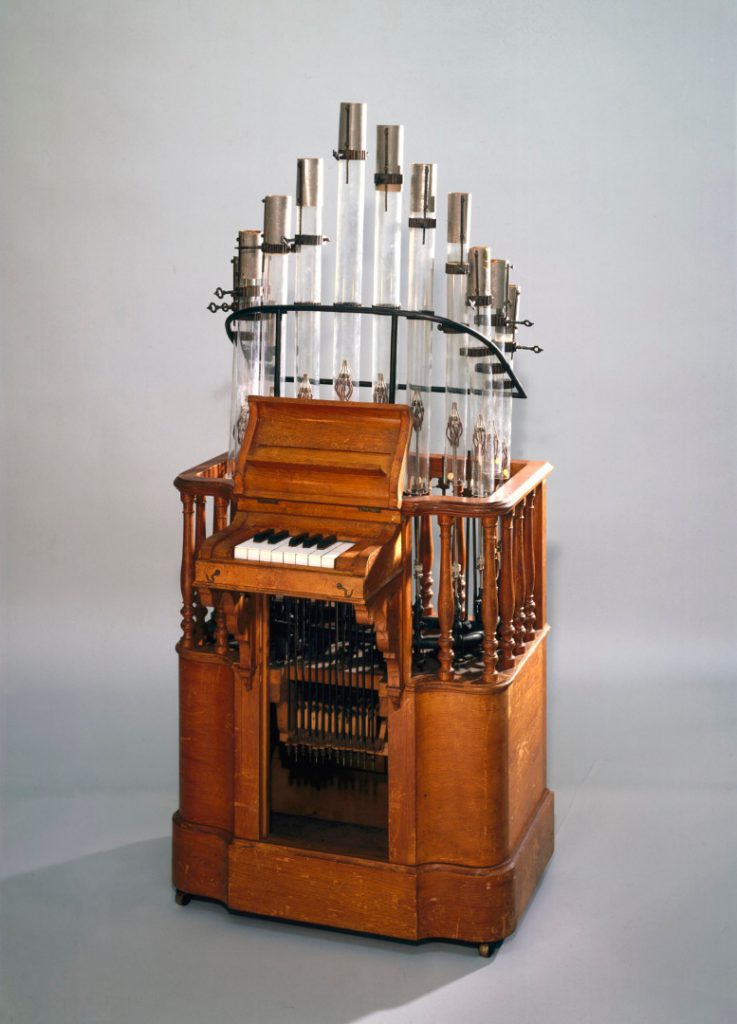
The fact that the curator Victor Chew was, from the late 1950s, intent on actively collecting sound recording and reproduction devices, as Jennifer Rich has shown in her article in issue 07 of this journal – means that we are able to create a nuanced display on this aspect of the history of listening (Rich, 2017). This would not need to be a technical history of recording technology, but could respect recent scholarship, which has shown that recording has led to several different kinds of revolution in music (see Sterne, 2003; Katz, 2010; Pinch and Bijsterveld, 2011). Recording detached the experience of music listening from the need to be present at a performance. It made it possible, even for non-musicians, to become deeply familiar with pieces of music and increasingly it made music into an accompaniment to everyday experience. After recording, music became ubiquitous, not just in the parlour, but in the city, and in the cinema where it became a key component of representing and experiencing modernity. The Science Museum Group collections represent the technology of sound-on-film, and inclusion of one of these devices could readily become the focus for a surprising display of the way in which filmmakers and artists very soon began to use such equipment not only to record dialogue, but to create different kinds of sound collage that effectively amounted to musique concrète more than a decade before the term was coined (Cox, 2017; Boon, 2018). These less well-known examples of the impact of recording on music could be used to provide a genealogy and a context for other aspects of recorded listening, such as the interaction of disc recording durations with musical form, including the three-minute pop song. At another level, sound recording instruments have been pressed into service as analytical instruments, and this is seen in the collecting traditions of ethnomusicologists as much as in individual composers’ appropriation of folk forms. Béla Bartók was, for example, able to study Eastern European folk music because he could closely study recorded Edison phonograph performances (Bartók and Baker, 1933, p 271). Glen Gould perfected his 1955 Goldberg Variations by listening back to his own practice performances (Elie, 2012). New York Minimalists built a whole genre on the foundation of tape loop music; and hip-hop and sampling-based music translated art music into the mainstream. Sampling also has a genealogy as could be shown via a musical device from a very particular technological niche: the Mellotron, launched in 1963, is a musical instrument where each note on a conventional musical keyboard triggers the playback of a length of magnetic tape carrying a tuned recording. This did the job that a decade and a half later began to be done by digital samplers. In addition to three instruments acquired from the manufacturers, Streetly Electronics, SMG holds the Mellotron purchased by the BBC in 1963–4, where it was used as a sound effects databank (Niebur, 2010, pp 125–7).
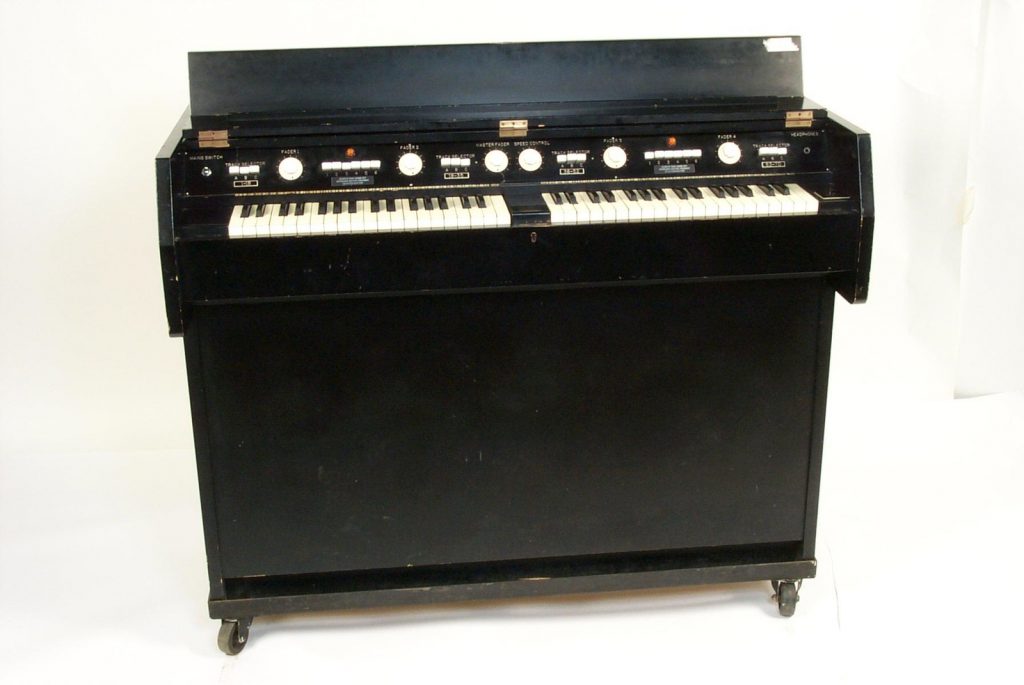
It will be evident to those that know it, that our discussions on the revolutions wrought by recording would be haunted by Jacques Attali’s division of the history of music into three ages, which defines our modern era as a phase that is dominated by the existence of recording. In Attali’s account, our current age has the tag ‘repeating’, since recording has enabled the ‘stockpiling of music’. It is an age that is radically different from two earlier eras; one dominated by notated music and another, pre-modern, pre-notational period where music was marked by particular ritual associations (Attali, 1985).
Myles Jackson’s demonstration-lecture in the third workshop showed that the Science Museum’s acoustics collection holds a good selection of the significant acoustical instruments that he had already explored in his work Harmonious Triads. As Jackson shows there, nineteenth century physicists used musical instruments as experimental systems; in turn their research helped musicians in their performances as well as leading directly to improvements in the design and manufacture of musical instruments. The musical reed, for example – as Jackson showed using a tonometer made by Appunn and a concertina by Wheatstone – was a mainstay of those engaged in uniting music and physics. It enabled precise tuning and therefore determination not just of ‘absolute’ pitch, but also of relative pitch in the sense of addressing the problem of temperament in keyboard tuning, where a compromise always has to be made between mathematically equal intervals and those that sound tuneful in each key (see Jackson, 2006, pp 153–7). This was part of the important theme of standardisation, where music is of a piece with many aspects of nineteenth century science. Here, as Jackson showed, instrument makers worked with musicians and researchers to create devices such as tuning forks and metronomes, that could be used to address local differences (for example creating a standard pitch of concert A), the tempo at which pieces would be played, and solutions to the temperament problem. Had it been practical to transport the Museum’s enharmonic harmonium from storage in Wiltshire, the workshop audience would have witnessed another exhibition display candidate which, with its with 84 keys per octave, is a survivor of the nineteenth century debates on temperament.
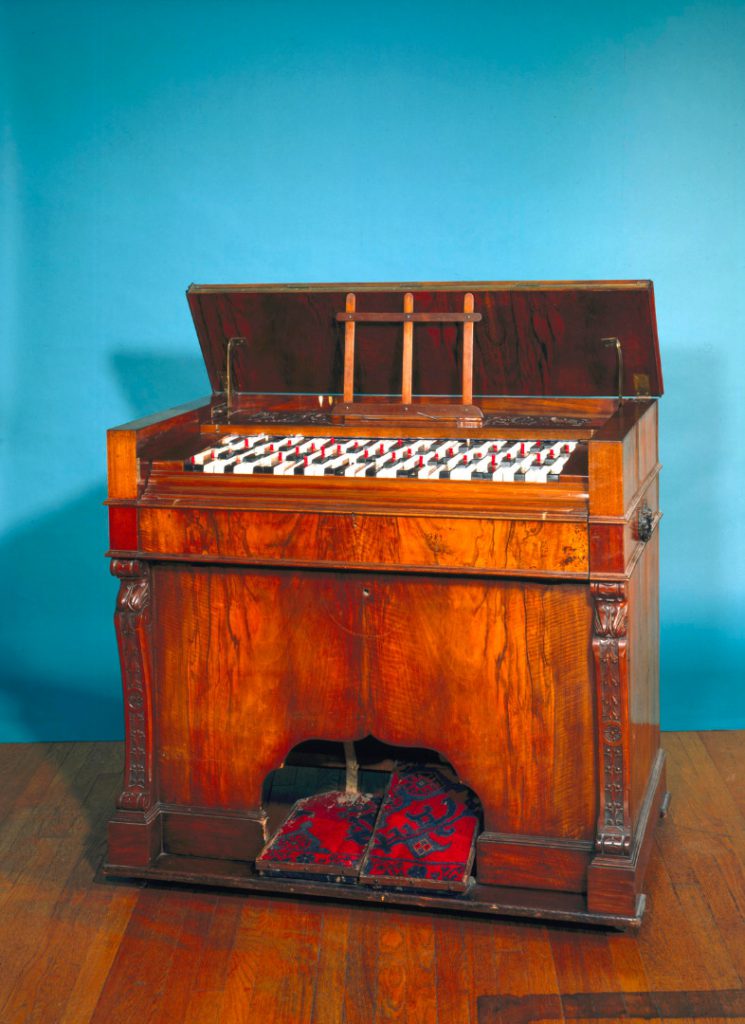
Incidentally, the display of a concertina, not as the folkish thing it is now generally seen to be, but as the archaic high-tech of 1829, could supply one of those elements of surprise that are part of the toolkit of exhibition curators; Charles Wheatstone, the scientific instrument maker and scion of a musical instrument-making family, launched the English version in that year.
As some of these examples imply, today’s curators work on the basis that the potential narratives to which objects belong are not limited by the conceptual worlds of those that collect them. This was also seen in the workshops. For example, when Tom Rice spoke of Florence Nightingale’s perception of the curative power of peacefulness, he opened up the possibility that Nightingale’s moccasins, which the Museum holds as part of the Wellcome collection, could go beyond simply being thought of as personalia, and present themselves as surprising candidates for display in the context of noise and health.
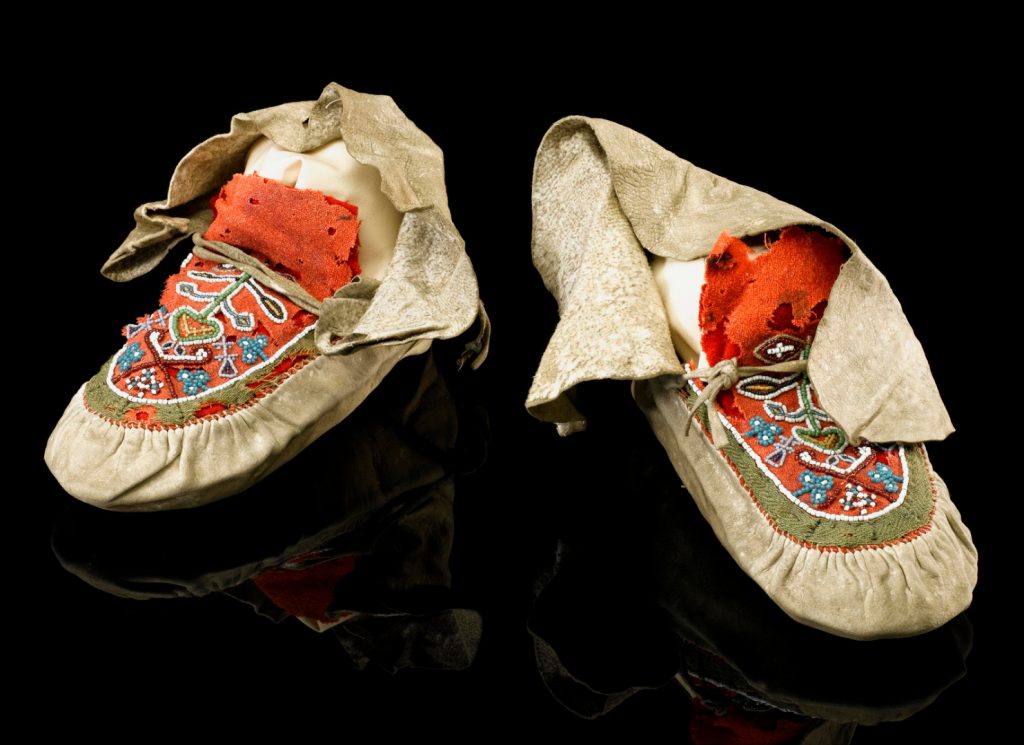
These are just a very few examples of objects that might be displayed under the ‘history of listening’ rubric, and it awaits further research to reveal the many more candidate display objects in the collections, especially the RCM’s collections, which were not explicitly addressed in the workshops.
Activities, musicking and museuming
https://dx.doi.org/10.15180/170814/008An implication of opening-up participation in the formulation of an exhibition, as we did with the workshops, is that we should explore how this spirit of participation might be extended throughout the exhibition-delivery process. Here we can draw on other music-related projects at the Museum in addition to the workshops to discuss this theme.
The workshops included many kinds of activity: practical tasks, concerts, talks designed as provocations to discussion, and dialogic introductions. Each of these modes has potential for any future exhibition and its associated public programme. In the Music, Noise and Silence events we deliberately programmed practical exercises to ensure that these were genuinely workshops, not simply conferences by another name. These included the visit to the anechoic and reverberant chambers, the group re-enactment of a sound effects recording and the light-Theremin building workshop. The consensus of the participants was that these kinds of activities could very naturally be offered as part of the programming associated with any exhibition on this theme. It would, the Audialsense collective confirmed, even be possible to include an anechoic chamber within a travelling temporary exhibition. Such chambers can be constructed in a horseshoe-shape so as to be ‘walk-through’. Equally, the workshop concerts suggested how musical programming could encourage reflection on, and enjoyment of, exhibition themes. This could even extend to the compositions that Myles Jackson discussed, where nineteenth-century acoustical devices including metronomes and sirens have been pressed into service to make twentieth-century music (See also: Jackson, 2012). With an active participation strategy, the exhibition could include performances from a wide range of people we might otherwise think of as visitors. Finally, in terms of provocations to think differently about the show’s themes, an object used well within a display can always provoke a response, conscious or unconscious. At any rate, the workshops, performances and activities were highly suggestive of the potential for further, more public experiments in participation around the workshop project’s themes.
Participation in the workshops went beyond these programmed moments of activity. At each of the meetings, with the aim of enriching the conversation, we extended the normal convention of starting with introductions round the table, and asked each participant to bring ‘a relevant sound or thing’. As a warm-up to further provoked discussions, this technique proved effective in building the esprit de corps of the workshops, as participants played short sound excerpts, presented objects or pictures, in each case elaborating on its relevance to the discussion. We may think of this as reproducing in a self-conscious and dialogic manner the commonplace that everyone brings something of themselves to any cultural encounter. As well as suggesting an effective way of encouraging discussion and collaboration in future research workshops, this exercise is also suggestive of how we might approach an exhibition, especially one predicated on the assumption of a substantial visiting public with interest in, and therefore knowledge of, differing kinds of music. In the case of exhibition visiting, commentators think of this model of engagement where consumers bring something of themselves as ‘contributory’, in the sense that the museum visitor’s previous life experience, understanding and knowledge are taken to be the major determinants of their experience. We see in George Hein’s notion of the ‘constructivist museum’, the fundamental assumption that, as museum visitors, ‘in order to make meaning of our experience, we need to be able to connect it with what we already know’ (Hein, 1995; 1998). A compatible model for museum visiting can be extracted from Michel de Certeau’s model of cultural consumption as ‘poaching’, where audiences bring their own needs and take what they want from a cultural experience, just as a poacher steals the hare from the landlord’s field. A kind of contributory model may also be seen in deficit – as with the science capital approach, where social inequalities are understood to prevent engagement with science, which it is then the role of informal science education (including that which takes place in museums) to supply (Archer et al, 2015).
Christopher Small’s notion of ‘musicking’ – mentioned in David Toop’s provocation – can help us here with a musical route to enriching the debate about participation in museums. Small argues against the notion that the musical score is what music really is, contending that music is an activity, not a thing: ‘the fundamental nature and meaning of music lie not in…musical works at all, but in action, in what people do’. He defines a new word, ‘musicking’ to address this alternative approach to the problem, and he defines it:
To music is to take part, in any capacity, in a musical performance, whether by performing, by listening, by rehearsing or practicing, by providing material for performance (what is called composing), or by dancing.
(Small, 1998), p 9
Small’s list of forms of ‘musicking’ can be taken to extend to singing in the shower, cleaning concert halls, promoting, streaming, selling and buying recordings, visiting music web- and social media sites, and writing and reading music criticism or fanzines. The implication is democratic: music is not music if it doesn’t have listeners, and is impossible if not sustained by practical activities, financial support and communities of interest. In sum, music as a practice involves a huge range of activities without which it would not be ‘music’ as we currently experience it. Accordingly, we propose that a visit to a music exhibition might be seen not so much as an invitation to passively consume, but actively to musick, if we design it to be such.
Just as it helps in understanding music to think of it in terms of activity, then we may also extend the principle to museums, where the term ‘museuming’ would surely connote taking part, in any capacity, in a museum experience, whether by curating, by visiting, by talking to one’s family and friends about the experience; by more actively participating by attending events, reading catalogues, contributing to funding by buying tickets or sandwiches, donating objects, and many other activities besides.
The range of people involved in our three workshops represent, perhaps, an inner circle of ‘musickers’, in the sense that all have an active pre-existing interest in sound studies, musicology, composition or performance. The relationship of most of them to ‘museuming’ had up to this point generally been at the downstream end of museum visiting rather than at the upstream end of curating. But this was precisely the point of the exercise: we aimed to bring exhibition consumption into dialogue with production. And this goes beyond de Certeau’s point that consumption is a form of production ‘characterised by its ruses, its fragmentation…its poaching, its clandestine nature, its tireless but quiet activity [that] shows itself not in its own products…but in an art of using those imposed on it’ (De Certeau, 1984, p 31). It suggests that an exhibition on science, technology and music would be very much able to open itself up to a contributory model of exhibition, both ‘upstream’ in exhibition production and ‘downstream’ in the consumption of displays. The Science Museum’s 2011 Oramics to Electronica exhibition employed a participatory methodology that went beyond the by-now-familiar model of participation for the sake of social inclusion into cognitive aspects, exploring how lay experts understand museum subjects. There, electronic musicians and enthusiasts were invited to do the job of the curator, providing their own accounts of the history of electronic music (for a summary of participatory practice, see (Boon, Van der Vaart and Price, 2014) for a later project, see Graham, 2017, pp 159–60).
The argument via musicking and museuming – that a music exhibition could belong both to an extended practice-based conception of music and to a more capacious understanding of museum practice – opens up a field of creative possibility in which some visitors’ participation could be extended to collaboration. This could address some core questions: What objects and subjects should feature in the display? Whose knowledge is encoded in the exhibits? How do we go about research, and who should do it? But this approach also suggests a warmer, more participative view of the more ‘downstream’ kind of participation by the visitor with the exhibition. It also suggests that close attention to the mis en scene of the exhibition and the experience of interaction within it will be essential.
The subjects of music and listening lend themselves to a sonic-theatrical style of exhibition. The fundamental importance of the visitors’ listening experience in such an exhibition emerged as a dominant theme throughout the network events, with a call for the creation of sonic environments within an exhibition that allow for different modes of listening. It would be very curious to produce an exhibition on sound or music that didn’t invite the audience to use their ears every bit as much as their eyes. In Oramics to Electronica, some of the participants were critical that it proved impossible to hear the displayed instruments. In that case a selection of sound films partially filled the void, but the criticism was fair. Museums tend to be predominately visual places that hear sound as nuisance (see Rich, 2017). But we should consider whether the punning application of Varèse’s ‘organised sound’ notion could be taken quite seriously, with the sounds of the exhibition being orchestrated to run in a particular sequence, that is that the soundscape of the show should be composed (for the broader context, see Schafer, 1984). It would be possible to avoid cacophony if exhibits were orchestrated to be noisy in sequence, rather than all at once. This would resonate with Sally-Jane Norman’s suggestion, in the last workshop’s summative discussion, that any exhibition should aim for ‘a more immersive or multi-sensory experience’. This could provide a social complement to the headphone-wearing individual musical exhibition experience of an exhibition such as the V&A’s David Bowie Is. The show’s soundtrack would itself veer towards being a composition, one necessarily responding to the needs of the visitors, as in Christopher Small’s sense that a score needs performers and audiences to be music. Intriguingly, a sequence of sounding exhibits would also introduce a music-like duration into the planning of the show. There would be an interaction between the choice of exhibits and the desired dwell-time within the exhibition. Within such a conception, for example, one could imagine an installation version of Angliss and Radcliffe’s The Machinery: Clog Dancing as Early Noise Music which would be part-way between event and object; it would have its own duration, like a ‘movement’ within the whole sonic composition, and it could have a physical presence that could incorporate video and sound material with, perhaps, a Lancashire cotton loom from the collection and other contextual and visual items. The duration of quoted works of music within the exhibition – for example, the limit of a 78 RPM record – would be a factor in their inclusion in the soundscape. And the sequence and draw of sounding exhibits would be understood as provocations for the audience to engage (or to refuse to engage) with the music-like durations of the show’s soundscape programming. Whatever sonic solution is found, the work of the architects and acousticians of the Audialsense collective demonstrated in the second workshop a good example of a kind of listening that is alive to a full awareness of an exhibition’s acoustic.[30] Furthermore, the live programming of concerts and events as discussed above could be envisaged as a contribution to the life of the show; promoting knowledge exchange rather than knowledge transfer, providing a less pedagogical frame than is the norm, and inviting knowledgeable contribution.
In sum, the implication is that it would be possible to (co-)produce a kind of exhibition that is not simply consumed by visitors, but one which is in a sense a combination of event programme and display.
Conclusions: Networking and exhibiting
https://dx.doi.org/10.15180/170814/019It should be admitted that the use of workshops of interested experts to fertilise display making is more a matter of degree than an absolute departure from established museum practice. Exhibitions in large museums of science are necessarily collaborative endeavours: they bring together different professional groups – of curators, content developers, audience researchers, designers, project managers, object conservators, lighting specialists, filmmakers, builders, fundraisers and the rest – and they grow in the soil of very particular institutions, with varying balances of nutrients. Certainly, it is not unusual at the Science Museum, especially in contemporary science exhibitions, to engage specialist advisors to act as sounding boards or fact checkers downstream of the conception of a show. But deliberately opening-up of the conception of an exhibition to the influence of the kinds and numbers of people who were involved in ‘music, noise and silence’ was novel.
At the end of this meditation on the applicability to a potential science and music display of insights gained from this workshop series, it makes sense to address two questions in particular: whether an exhibition on this theme would need to address the broader context of the noise of industrial modernity, the ‘peg’ for the workshop series; and whether an exhibition that could be participatory in the extended sense sketched above should be.
The answer to both lies with how we conceive of the majority audience for any proposed show. Locating the theme ‘a history of listening’ explicitly within industrial modernity implies an invitation to think of a familiar subject in a new way; this is a kind of curation that has more of an art curating flavour than the more pedagogical traditions of science exhibitions. Such a demand on the visitor might well be more welcome to an audience with an active commitment to music greater than the average. Equally, an exhibition could allude more fleetingly to the historical context of the industrial era before concentrating on a series of examples of science-technology-music interactions. The question here is whether a science museum, particularly, should emphasise this context. Certainly, to do so could be a factor in ensuring – beyond the use of particular collections – that this would be a show that really belongs in a science institution rather than, perhaps, a conservatoire or decorative art museum such as the Victoria and Albert, which also exhibits musical instruments.
Clearly, an exhibition on this theme is not required to be participatory in its production. We can hope that, armed with an understanding of the breadth of discussion at the workshops, any new exhibition on this theme will be equipped to present a genuinely original approach, and to avoid the clichés of focusing too closely on technical development at the expense of broader cultural aspects. But it may well be that the invitation to participation is particularly beneficial in how we conceive of the consumption of any music show. Here the suggestion is that both the experience of the show, with its composed soundscape, and the ‘fringe’ of well-chosen events and programming, could act to broaden the audience member’s involvement, as a simultaneous form of musicking and museuming.
Editor’s note
This paper is the result of collaboration by several people involved in the project. Aleks Kolkowski and Tim Boon did a large part of the writing, James Mansell and John Kannenberg contributed valuable material and Annie Jamieson critiqued and edited the final version. The authors would also like to thank all of those who contributed to the workshops themselves. This project was funded by the Arts and Humanities Research Council, ref: AH/M008061/1.
Tags
Footnotes
Back to text
Back to text
Back to text
Back to text
Back to text
Back to text
Back to text
Back to text
Back to text
Back to text
Back to text
Back to text
Back to text
Back to text
Back to text
Back to text
Back to text
Back to text
Back to text
Back to text
Back to text
Back to text
Back to text
Back to text
Back to text
Back to text
Back to text
Back to text
Back to text
Back to text

